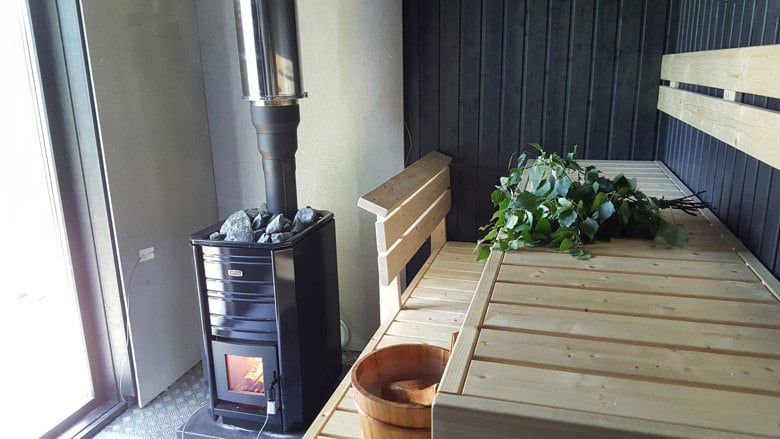Wood-burning sauna stove

This page provides tips on how to heat your wood-burning sauna with the lowest possible emissions.
Taking a sauna is pleasant and has many health benefits. This page provides tips on how to heat your sauna with the lowest possible emissions. See also the tips for acquiring and storing firewood.
These tips will allow you to enjoy your sauna with lower emissions:
- Take out any old ashes. Empty the ashes into a metal container with a lid or something similar in a fire-safe manner.
- Light the stove quickly. Use small and dry pieces of wood so that they kindle quickly. A lot of emissions are always generated during the ignition phase, but the emissions decrease once the combustion starts properly. The shorter the ignition phase, the lower the emissions.
- Burn dry wood (see tips for identifying dry wood).
- Do not burn rubbish of any kind. No milk cartons, sausage wrappers or any other waste.
- Burn wood in several batches. Do not fill the entire firebox. Start the heating with small pieces of wood and increase the size towards the end. Add new wood only when the flame dies down.
- Good combustion requires sufficient air. Adjust the air according to the instruction manual of the sauna stove.
- Take care of regular chimney sweeping. To ensure fire safety, fireplaces in permanent residences must be swept once a year and those in summer cottages every three years. The contact information of the chimney sweepers operating in your area is available on the chimney sweeper website: www.nuohoojat.fi (in Finnish).
- You can learn to use your sauna stove in a skillful manner by monitoring the colour of the smoke. If the smoke is dark or brown, emissions are really high. If the smoke is colourless, burning produces fewer emissions. You can try to make the colour of the smoke lighter with the help of the operating manual of your sauna stove and these tips.
Heating wood-burning sauna stoves reduces air quality
The use of wood-burning sauna stoves and other fireplaces reduces air quality in densely built detached housing areas. Wood burning always produces emissions of fine particles and PAHs that are harmful to health, as well as emissions of black carbon that accelerates climate change. In poor combustion, the emissions generated are many times higher. You can influence the amount of emissions with your burning practices.
Sauna stoves have the highest emissions out of all fireplaces. Approximately half of Finland’s fine particle emissions originate from wood burning in households, and sauna stoves account for a significant share of these emissions.
However, wood burning is not going to be banned or restricted. The new National Air Pollution Control Programme does not mention any bans, but aims to reduce emissions through communication, advice and technology.
National Air Pollution Control Programme,
There are differences in the emissions of sauna stoves – where to get a low-emission stove?
The emissions of different sauna stoves differ greatly. The biggest factor affecting the emissions of sauna stoves is how combustion air is conducted into the firebox. Primary air is air that is supplied to the combustion process from below. In addition to primary air, good combustion requires secondary air, which is supplied to the combustion process from above. In the final report of the KIUAS2 project, you will find the latest research information on the emissions of wood-burning sauna stoves and information on the selection of wood-burning sauna stoves.
A new CE-marked stove usually has lower emissions than an old sauna stove. However, the sauna stoves currently on the market can be developed to have significantly lower emissions than at present.
It is also good to be aware that the emissions from the same wood-burning sauna stove can be multifold, depending on the burning practices. When you learn how to light your wood-burning sauna stove in a proper manner, the emissions will decrease significantly.
KIUAS project investigated sauna stove emissions
The KIUAS project on the emissions of sauna stoves and reducing them measured the emissions of the most common wood-burning sauna stoves. Reducing the emissions from sauna stoves is particularly important because their emissions are clearly higher than those of other fireplaces. The results of the project will be used to develop sauna stoves with lower emissions than current models in cooperation with stove manufacturers.
The research results of the KIUAS project are available on the website of the University of Eastern Finland. Participants in the project included the University of Eastern Finland, HSY, the Finnish Environment Institute, the Ministry of the Environment, the Ministry of Social Affairs and Health as well as the cities of Helsinki, Kuopio and Turku.
Results of the KIUAS projects